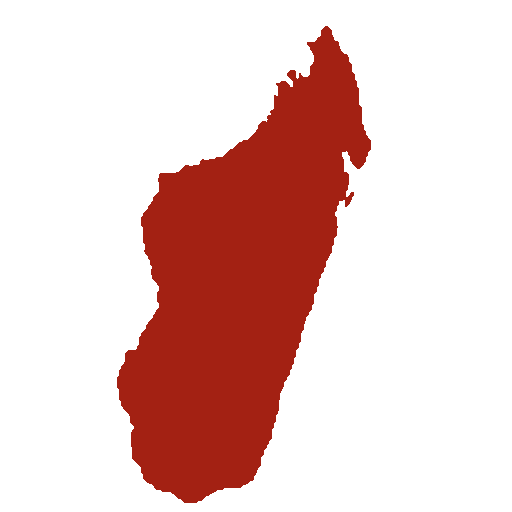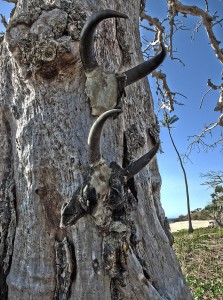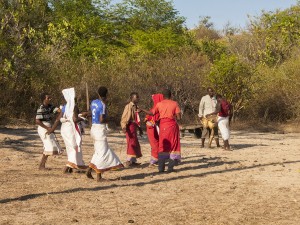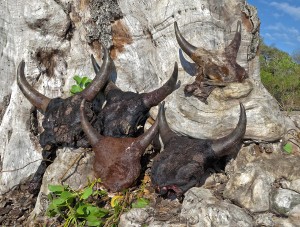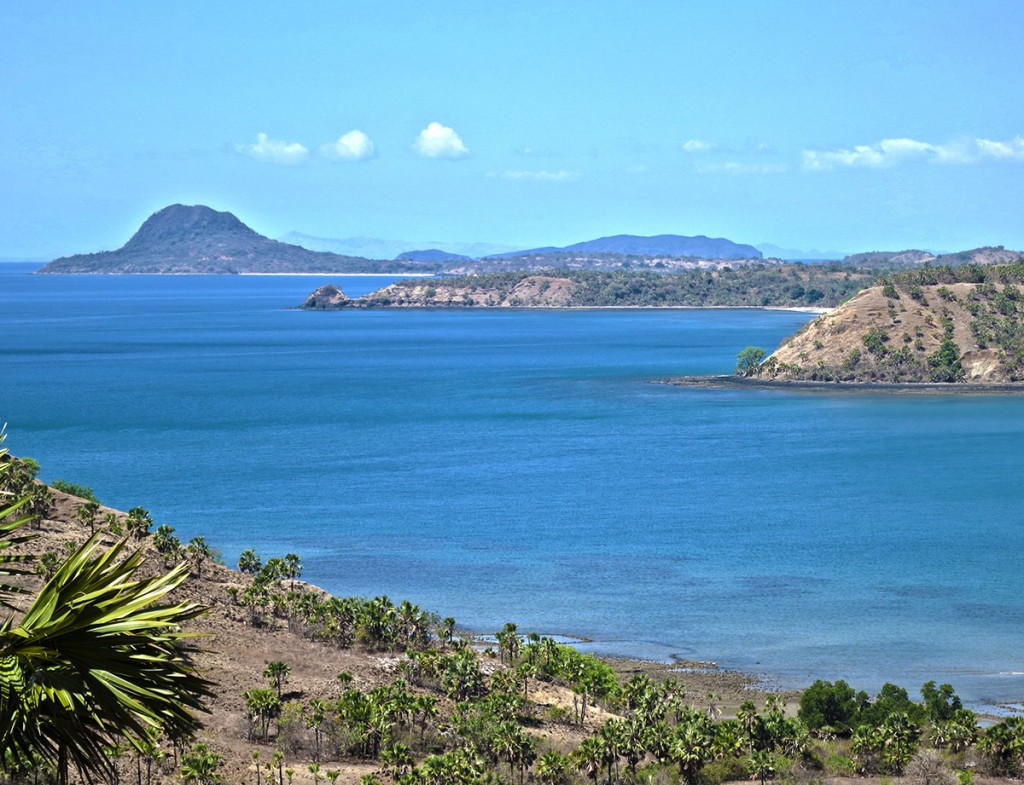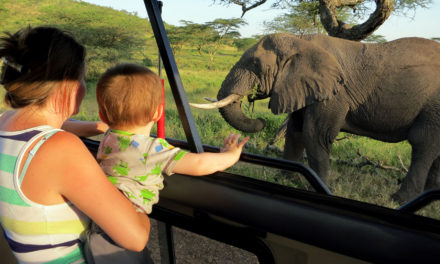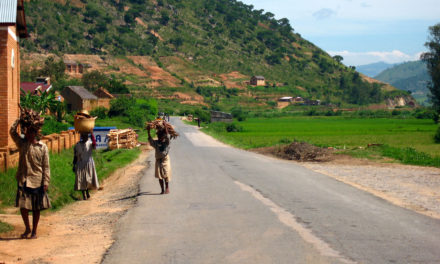S everal scattered skulls, the stench of rotting flesh, and a handful of abandoned shacks were the only things remaining from the week’s festivities that ended just that morning. The quietness of our village was typical and not unexpected, but it was still a huge difference from the hundreds of people partying and worshiping their ancestors here during the preceding days.
Once every five years in October, the Antakarana people have a multi-part ceremony/celebration called the “tsangasaina”. The first part happens here in our village of Ampasindava on Nosy Mitsio. Here is where the Antakarana ancestors escaped the Merina tribe during the Merina’s national conquests a couple hundred years ago. Here the Antakarana’s tribal leaders and remaining people waited anxiously in Ampasindava, behind a hill on the west side of Nosy Mitsio, closest to the mountain island of Nosy Ankarea. They had lookouts stationed on the tops of the hills looking east, ready to send the signal if the Merina pursued them this far. As soon as they received word of the approaching Merina, they were ready to quickly go to Nosy Ankarea, hike to the flat top of the mountain, and fight until the death of every last one of them. They never received the signal, the Merina never came this far, and they erected a group of sacred stones in Ampasindava to remember the occasion and celebrate the survival of their tribe and the help given by their ancestors.
The second part of the “tsangasaina” ceremony will happen a couple weeks from now, in Ambatoharanana. There the Antakarana have long buried their royal ancestors in a group of large caves, and there they first hid from the conquering Merina. Many of the Antakarana died there before they decided to escape at a further distance from the Merina, to Nosy Mitsio. The name “tsangasaina” means, “the raising of the flag.” We haven’t yet seen any flags raised in this ceremony, but expect that maybe that portion happens there in Ambatoharanana, or maybe it’s a leftover name from an older custom.
W e were headed back to Nosy Mitsio from mainland Madagascar shortly before the first part of the ceremony was supposed to begin in our village. We hoped to get back at least a few days early, to prepare our temporary place and secure our possessions against the huge crowds we heard were supposed to arrive. But thanks to our ever-persistent transport troubles, we only managed to depart for Nosy Mitsio at the same time as all the other arriving visitors from the mainland.
Shortly after midnight, during the calmest time of the ocean, we were in our boat, all packed up with another full load of building materials intended for one of our team members’ homes. There were probably well over a hundred other people milling around the dark port in the middle of the night, getting in and out of the boats waiting there for them. There were no overhead lights and few flashlights, so it was hard to tell what was really going on. Our boat was still scheduled to leave before everyone else, but all of a sudden the head King of the Antakarana arrived in his truck. It would be disrespectful to leave before him, in his presence, so we waited for his preparations to be made.
The first boat intended for the King turned out to have a bad motor. No surprise there; even the royalty of the Antakarana suffers the same problems as everyone else travelling that route. People and boats were shuffled around and hours later, not long before sunrise, we all left, with all the King’s accompanying boats chanting and singing for his departure.
A couple hours after sunrise, we all arrived at Nosy Mitsio. First, the King and his entourage stopped on the east side, and from there they trekked to Ampasindava in the west, following in the footsteps of their ancestors on their historic voyage nearly two hundred years before. They arrived in Ampasindava with a crowd of women chanting and singing. The crowd accompanied the King into his royal house, and from there they seated him near the beach on one of the only chairs that exists in Ampasindava (all of them new for the festival), under a makeshift palm-leaf shelter for shade. Not long after that, the first two cows were sacrificed and most of their meat distributed among the hundreds in attendance. It was time to celebrate!
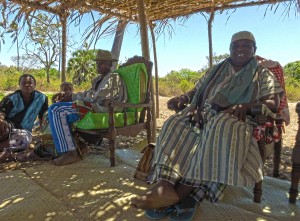
King Issah - traditional leader of all the Antakarana people, seated in the shade at the ceremony on Nosy Mitsio. Everyone there had to wear the traditional wrap in his presence and sit lower than him (on the ground).
T he next four days of the ceremonies had much the same feel as the first. It seemed like part historical reenactment, part religious conference, and part excuse to party. A dozen or more temporary shelters were erected both for visitors from the mainland and for those from more distant parts of Nosy Mitsio. For everything there was a “fomba” – a “way” that it was supposed to be done, for fear of offending the ancestors if done differently.
All of the men, including myself, had to wear one of the traditional printed cloths wrapped around our waists, because during the whole festival we were “in the presence of the King.” The women also had to wear the traditional cloths during the whole time, but they still regularly wear those cloths on normal days anyway. There was a special greeting, spoken and gestured, for the King the first time he’s passed by in the morning. Depending on the day of the ceremony, the beef received from the sacrifice that day could be used in different ways (some days drying it, or giving the bones to dogs was not permitted – instead the leftovers had to be thrown into the ocean). Using it in a non-prescribed way risked offending the ancestors. On one of the last days of the ceremony, everyone made coconut rice, but a special prayer and gestures had to be done during its preparation, to offer it to their ancestors.
There was a day that everyone was supposed to bathe in the ocean, with no clothes at all except the traditional cloth, and each person had to fully submerge themselves six times. Or was it eight times for the women? The truth is, there were so many “fombas”, “ways” of doing things just right in order to please the ancestors, that I have no idea how anyone could keep track. The ones I’ve mentioned are some of the very few, and there were many more that I neither recognized nor understood. The whole thing is run by most of the oldest and most prominent members of the Antakarana tribe, and I guess repeating the “fombas” once every five years from the time they were little kids is enough for them to keep everyone in line by the time they get old and lead it themselves.
There was one sort of dance/reenactment constantly repeated dozens of times every day that included two drummers and six actors/dancers wearing particular costumes and headdresses. The dancers had to move a certain number of steps depending on the rhythm of the drum, turn in a certain direction depending on whether they were moving forward or reverse, wave their wooden sticks/guns and white cloths around at a certain time, and eventually arrive at the sacred stones where they’d bow down and make an offering to their ancestors. Mostly it was younger people participating in this, but there was always at least one older person standing at the side, constantly interrupting them and correcting them to make sure they’d do it just right. A lot of different people asked me or Lora to participate in it with them, but thankfully the confusing complexity of it all was enough of an excuse to get us out of it.

The King of the Antakarana giving a long speech to the ancestors before offering them a sacrifice at the sacred stones.
At one point near the end of the ceremony, everyone gathered around the King, who led them to the sacred stones. No shoes or hats could be worn there and the King wore some sort of funny-looking 19th century military garb. A cow was hauled up in front of the stones where some young men made motions as if to sacrifice it. The King gave a long speech to the ancestors about a variety of subjects, but a significant portion of the speech was dedicated just to explaining the presence of Lora and me, and of our team members who will arrive next year. The King asked the ancestors to bless us, not to curse us, and to excuse our ignorance when we don’t know the right “fomba” (“way”) or we accidentally violate the “fady” (“taboos”). The next day, the largest cow of the ceremony was sacrificed as an offering to the ancestors for both our house and the recently completed royal house – to make sure the ancestors stay happy and that no one involved in the building or habitation of the houses will be cursed.
Some nights, all night long until sunrise, troops of people clapped out a rhythm and sung/shouted their way to and from the King’s royal home. That also happened to be the path right next to our temporary hut where we tried our best to sleep through the night despite the noise. Other nights, groups of men would gather in their best Muslim garb (plus the traditional cloth wrapped around their waists), sit around in a circle, and sing the same Arabic chants for hours straight. I don’t know if they knew what they were singing then, but at least one man claimed to understand the words.
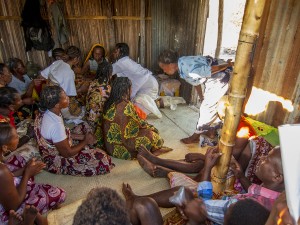
One of the many "tromba" (spirit possessions) performed in the King's royal home in our village on Nosy Mitsio.
Every afternoon, and some mornings, people gathered in one of the two rooms in the King’s royal house. It was mostly older women, but occasionally men, and sometimes younger people as well. Often enough, there were also spectators at the doorways and window. There they sometimes sang, sometimes beat out a rhythm, sometimes played a stringed bamboo instrument, sometimes shouted, sometimes drank water from a plate filled with rocks, or sometimes just drank rum. But the goal was that at least some among them should be possessed by the ancestors, speaking through them to reveal the fortunes of the people around them, to explain curses and how to remove them, or to guide them in the right practices (“fombas”) that would elicit blessings from their ancestors.
I almost never understood any of it, but the crowd of spectators sometimes swelled depending on who was possessed or who was receiving the communication. Everyone wanted to know what the ancestors had to say, either about themselves or about the people who inhabit their communities with them. From my perspective, all I could see was occasional seizure-type movements, some apparent fainting, some barking/shouting, and some low-voiced speaking into the ears of someone present. Interestingly enough, it was often the same one or two older women being possessed every time, and soon after being possessed they apparently had the presence of mind to change into the appropriate traditional outfit before sharing someone’s fortune. They also seemed to make pretty good money from the whole situation. But sometimes the spirit possessions happened with random people in the temporary shelters as well. It was a full-blown spiritual conference.

Some of the kids having a great time dancing to the lights and music powered by a visitor's generator during the first night of the ceremony.
And every night, regardless of what customs or ceremonies some people were engaged in, others were drinking and dancing to the music of whoever’s generator powered the loudest speakers. Every day, one or more cows were sacrificed and most of the meat distributed – a very rare treat for those of us who live on Nosy Mitsio, but when repeated every day it just seemed like luxury. The truth is, the whole thing was quite enjoyable. Our village wasn’t empty anymore, people were excited to see us and talk to us, and there was an abundance of food like we’ve never seen on Nosy Mitsio. We had a good time! (Though we lacked sleep.)
A nd then all of a sudden it was done! On the fifth morning, in a very short period of time, everyone was gone and our village was silent again. There was a bit of mess and there were the abandoned shacks. Other than that, it was the west wind blowing the stench of rotting cow heads stacked around the tree opposite the sacred stones that gave the only reminder of the major effort that had taken place in the days before. All that trouble and nothing remaining but emptiness and the smell of death.
During the festival itself, I was struck by how much life there was in our village that’s usually quite tiny and quiet. So it was a stark contrast the day everyone left, that it could all disappear so fast, to be replaced only by death. Then again, the whole point of the festivities was to remember and appease those who’ve been long dead. I suppose there was no other fitting result.
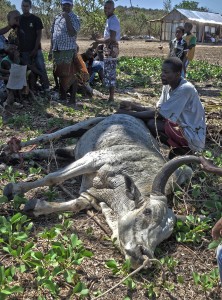
The largest cow sacrificed on the final day of the ceremony. (Though they actually sacrificed two more cows after that to make sure the ceremony was ended in a way pleasing to the ancestors.)
For most Malagasy people, worship of their ancestors (including costs such as sacrifices and tombs) are their largest expenditures – even more than buying food or building their own homes. It’s unfortunately one of the primary things that continues to limit Malagasy people’s access to education and development of their communities. On Nosy Mitsio, every family with a small herd of cattle is required to offer at least one bull for sacrifice at the “tsangasaina” every other time it occurs. Visitors from the mainland are required to offer massive sacks of rice.
The king of Nosy Mitsio, in whose village we live and who offered one of the sacrifices this year, later spoke to me after the festival. He told me he didn’t have enough money to send his son back to the university in northern Madagascar and he asked me for help. The full cost of tuition and fees and all the rest for the entire school year at the university is less than half of the cost of the sacrifice the king made at this year’s “tsangasaina”. But now his son can’t go back to the university because the ancestors had to be appeased. The festival was lively while it lasted, but the consequences seem to be more death than life. Again, if the focus is on death or those who are dead, then what else can be the result?
I t makes me think of its contrast with our own perspective, for those of us who follow Jesus. Yes, we remember his death; there’s no doubt about that and Jesus did something remarkable by it. But the full power of our faith is in his resurrection! We believe in the one who conquered all death, and that he who was first to rise from the dead will also raise us with him on the day that he fully brings the Kingdom of Heaven here to earth.
We don’t believe in some disembodied spiritual state of those who’ve gone before us – that they have power and authority to bless or curse our lives now, based on their whims or our appeasement of them. We don’t access our spiritual authority to gain power and influence in our current lives or to get revenge on our enemies. No, by contrast, we believe in the God whose power is so great that he takes death and turns it back into life. We follow the one who is redeeming creation as it is now, and who is recreating it all over again. He’s invested in our current lives, not because we’ve bargained with him to do what we want, but because he has a plan for us, along with the rest of Creation – to make all things new!
What a difference! Though to be honest, I don’t think we always see that difference as Christianity is often practiced in America. One of the most common evangelical questions is: “Where will you go when you die?” There’s no doubt that what happens to a person after death is incredibly important. But it’s just as important to ask “What is God doing in your life right now?” or “How are you participating with God in his plan to redeem the world around you?” In what ways are the Lord’s Prayer requesting God’s “Kingdom come on earth as it is in heaven” actually happening in your life or to those you interact with?
Some Christians are so focused on “going to heaven when I die”, that they seem to have a total disregard for God’s work in people’s lives now. They leave about as much emptiness and death behind them, or simply nothing at all, as the most devoted ancestor worshiper here in Madagascar. But our life now is part of our life to come. Focusing on God’s work in death to the exclusion of God’s work in our current lives doesn’t leave any fruit; there’s nothing of his Kingdom in it. If we do things that way, I don’t think that puts us American Christians much ahead of our neighbors here on Nosy Mitsio.
Instead, it should be known of us Christians that where we put our efforts and our resources, there remains behind and beyond us a new and abundant life. We don’t sacrifice our current lives to those who are dead, but we follow and are empowered by him who lives again. The God who makes all things new is also making them new through us. We pray and we believe and we act on it: that his Kingdom will come here on earth as it is in heaven.
